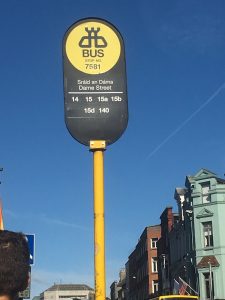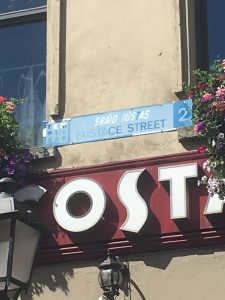

Despite Ireland’s global reputation for their loyalty to their native culture, in Dublin the traditional Irish language has taken on a purely symbolic role, with next to no functional purpose. Other aspects of traditional Irish culture are strongly preserved, such as the music and games, but linguistically, Irish has taken a backseat. While there is a clear effort to include Irish on governmentally-operated signage, it is rare to see the Irish language in other capacities and even more rare to hear it spoken in conversation. However, the inclusion of the Irish language in public signage is a nice nod to the centuries old traditions and reminds visitors and natives alike of the importance of those traditions.
The only two places you can consistently see Irish all over Dublin is on street signs and in public transportation. Every street sign has the Irish on top and the English on the bottom. Generally the Irish is in a slightly smaller font and is in italics, making the English much more visually prominent. This is similar to the English-Chinese dynamic in the second wave of Chinatown development (Leeman and Modan 352). The buses also announce every station in English and then again in Irish, and the bus stops have both languages displayed as well. However, almost everywhere else is just English. Occasionally there will be a pub or restaurant with an Irish name, but most stores have English names, English menus, and English signage. It is also extremely rare to hear Irish being spoken anywhere in Dublin. Students learn it in school, but in Dublin, almost every conversation takes place in English. These are all examples of how the Irish government has made efforts to preserve the Irish language, but outside of that realm, English is the dominant language. As English and Irish are both official languages, Ireland is officially a multilingual country, but in reality it is quite monolingual.
The structure of Dublin’s linguistic landscape is vastly different than that of D.C.’s Chinatown. While both landscapes have two main languages with English being the more dominant in both, the exploitative and commodified nature of the use of the Chinese language that has developed is not present in the use of Irish in Dublin. Irish, while primarily symbolic, is displayed because the government wants to preserve it. During much of the British occupation of Ireland, speaking Irish was illegal, and as a result, it almost died out. After independence, the government made a concentrated effort to promote the use of Irish because they considered it a “valuable cultural element worthy of preservation,” which is the exact opposite of Chinatown (Leeman and Modan 358). While both Irish and Chinese hold little functional value in their respective communities, the Irish language’s symbolic meaning comes from its cultural importance rather than cultural exploitation.
Overall, English is undoubtedly the predominant language in Dublin and across most of Ireland. In the western counties, Irish is more commonly spoken, but it certainly does not surpass English. However, by consciously including Irish in the linguistic landscape in a way that does not commercialize it, Dublin is able to save an important part of its culture.

I am surprised to learn that Irish is mostly of symbolic use and a means of cultural protection. We have to admit that English penetrates into all countries and cultures, but I am proud of the efforts of Irish government to try to protect traditional language. We don’t want the world dominated by English. We appreciate diversity.
It is a very interesting observation of Irish culture. Although I have never been to Ireland, I assumed that Irish was the vernacular language and spoken everywhere in Ireland. After reading your blog I did a bit research online and found that nearly all areas in Ireland use English except a small city called Gaeltacthts that speaks Irish day to day. I like the differentiation of cultural conservation in Ireland and the one in Washington DC Chinatown, as the former preserves Irish as cultural importance, while the latter uses ethnical difference—Chinese culture—in this case as a way of commodification. I hope Irish could be used more frequently in Ireland or at least enter semi-conversational level in the future!
Hey Jenny, do you think you’ll learn some Irish by the time you leave just by being exposed to it?
I think it’s really interesting that the Irish government goes to so much trouble to preserve the language, especially given that it is already nearly dead. While there is something to be said for keeping one’s culture intact, it seems like a waste of resources to include a language that hardly anyone speaks on so many public signs. An article I read recently said that around the world a language dies out every 14 days, and given this fact, I wonder how long the Irish government will hold out before they give up on trying to stop what seems inevitable.
I didn’t realize that Irish language had died out so much and that it was due to the British banning people from speaking it in the past. Although I think a majority would think it’s a waste to preserve something that is already fading away, the government trying to keep Irish around the landscape gives a reminder of the history of their land. To me, it’s never too late to bring something back, you just need to find people that find it worth doing so.